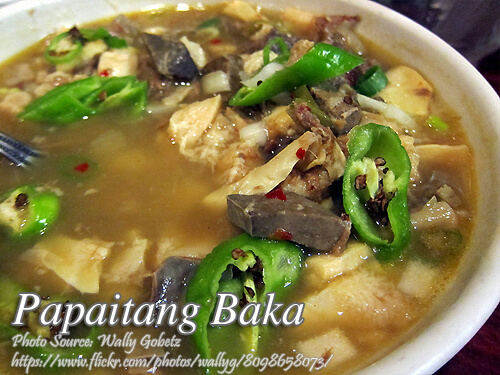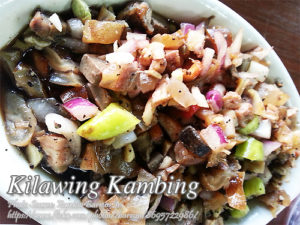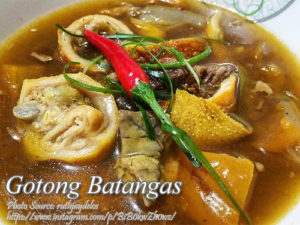Papaitan is one of the popular Ilokano dishes and the original recipe calls for goat innards. The reason why it is called “papaitan” is because the dish is bitter by using goat bile as one of the ingredient but just enough to make it tasty. Since goat innards are not always available in the market, you can substitute it with beef innards like this recipe I have here, the beef papaitan or papaitan baka. Add the red chili and pour the the bile little by little.
Papaitan Baka: A Bitter-Sweet Taste of Ilocos
Every time I think of papaitan baka, I’m transported back to my childhood in Ilocos. My Uncle Benny, who spent most of his life in the province, would prepare this dish with such mastery that even a simple meal turned into a celebration. The bitter, tangy aroma wafting from the kitchen was enough to make everyone gather around the table. While papaitan is traditionally made with goat innards, beef has become a more accessible alternative for many Filipino families. Today, I’m sharing how you can bring this beloved Ilokano dish into your own home with the comforting richness of beef.
The Origin of Papaitan and Its Unique Flavor
Papaitan, as the name suggests, comes from the Ilokano word pait, meaning “bitter.” This distinct bitterness comes from the bile, a key ingredient that gives the dish its character. Traditionally, it’s made with goat innards, but as goat meat isn’t always easy to find, beef has become a popular substitute. Using beef innards still provides that robust flavor, but with a slightly milder twist. It’s this bitterness that makes the dish stand out, balancing perfectly with the heat from red chili and the depth of garlic, ginger, and onions.
For many Ilokanos, this dish is more than just food—it’s a tradition passed down through generations. My cousin Elena recalls how her lolo would carefully portion out the bile, tasting and adjusting as he cooked. “The secret,” he always said, “is in knowing when to stop adding the bile. Too little, and it lacks character; too much, and it’s too harsh.”
Preparing the Beef for a Perfect Papaitan
The first step in preparing papaitan baka is ensuring that the innards are impeccably clean. My Aunt Linda taught me a trick she learned from her grandmother: wash and mash the innards with banana leaves and salt. This not only removes the musky odor but also infuses a subtle earthy aroma into the meat. The banana leaves, with their natural antiseptic properties, help eliminate any unpleasant scent while imparting a fresh undertone.
Boiling the innards until tender is crucial. This step softens the meat, making it more pleasant to eat and easier to absorb the flavors later. It’s a slow process, but trust me, the result is worth the wait. After boiling, cut the innards into small, bite-sized pieces. This ensures every spoonful delivers a perfect balance of textures—from the chewy innards to the tender beef tenderloin.
Layering Flavors Through Sautéing
Sautéing is where the magic happens. Start with ginger, garlic, and onion—the holy trinity of Filipino cooking. Sautéing these aromatics not only enhances their flavors but also creates a strong foundation for the dish. Ginger cuts through the richness of the meat, while garlic and onion add sweetness and depth. When you add the innards, the heat releases their natural juices, blending beautifully with the aromatics.
At this point, you’ll want to season with salt and pepper, adjusting as you go. This ensures the flavors meld together without overpowering the bitterness that will come later from the bile. Adding just enough water to cover the ingredients is essential for simmering everything to perfection.
Balancing the Bitterness of Papaitan Baka
Adding the bile is the most critical step, and it’s where many beginners hesitate. My brother Dante once joked that making papaitan is like walking a tightrope—one slip, and the bitterness overwhelms everything. The key is to add the bile little by little, tasting after each addition. Remember, you can always add more, but you can’t take it out once it’s in.
The red chili peppers are another important component. They add a layer of heat that balances the bitterness, giving the dish its signature kick. If you’re sensitive to spice, you can adjust the number of chilies or opt for a milder variety.
Serving Papaitan Baka with a Personal Touch
Once the beef tenderloin is tender and the bile perfectly balanced, it’s time to serve your papaitan baka. Garnish with chopped spring onions for a pop of color and a fresh, crisp finish. Serve it hot, with steaming white rice on the side.
For my family, papaitan isn’t just a meal—it’s a connection to our roots. Every spoonful is a reminder of family gatherings, stories shared over dinner, and the rich culinary heritage of the Ilokano people. Whether you’re cooking this dish for the first time or revisiting an old favorite, take your time and enjoy the process. After all, food is more than just sustenance—it’s a celebration of life, love, and tradition.
Papaitan Baka might be an acquired taste for some, but for those who embrace it, it’s a bold and hearty dish that offers a glimpse into the soul of Ilokano cuisine. Try it, and let its bittersweet charm win you over.
How To Cook Papaitan Baka (Beef Papaitan)
Ingredients
- 1/2 kilo beef internal organs tripe, liver, kidney, heart, pancreas, intestines
- 1/4 kilo beef tenderloin cut into 1/2" cubes
- 1/4 cup beef bile or apdo
- 1 pc medium size onion chopped
- 1 head garlic minced
- 1 pc ginger about 1 inch, slivered
- 1/4 cup chopped spring onion
- 2 pc red chili pepper or siling labuyo
- 3 Tbsp. salt
- 1/2 tsp. salt
- 1/2 tsp. ground pepper
- 1 Tbsp. patis or fish sauce
Instructions
How to cook papaitan baka:
- Wash and mash the internal organs with banana leaves with 3 Tbsp. salt to remove the musky odor.
- Make sure that the intestines are very clean.
- Boil the internal organs on a big pot until tender then remove from liquid and cut into 1/2 inch cubes. Set aside.
- Saute ginger, garlic and onion. Stir fry until the onions are cooked and add the internal organs.
- Stir fry again until some broth comes out of the internal organs.
- Season with salt and pepper and adjust the amount according to your desired taste.
- Stir fry for a few minutes then add some water, just enough to cover all the ingredients.
- Simmer and add the beef tenderloin until the tenderloin is cooked.
- Drop the red chili peppers and pour the bile little by little to prevent the dish from becoming too bitter.
- Season with patis and adjust the amount according to your preference.
- Serve hot and garnish with chopped spring onions.
Notes
Cooking Tips:
Properly Clean the Beef Innards
To remove the musky odor from the beef innards, wash them thoroughly with salt and mash them using banana leaves. This process not only cleans the meat but also infuses a subtle earthy aroma that enhances the dish’s flavor. Proper cleaning ensures a fresh-tasting papaitan baka without any lingering unpleasant smell.Control the Bitterness with Care
Add the bile gradually and taste frequently to achieve the perfect balance of bitterness. Adding too much at once can overpower the dish, so it’s best to go slow and adjust as needed. Remember, bitterness is essential, but it should complement, not dominate, the other flavors.Simmer for Tender and Flavorful Meat
Allow the beef innards and tenderloin to simmer long enough to absorb the flavors of the broth and spices. Slow cooking breaks down the tougher parts of the meat, resulting in a tender and delicious bite. This step also allows the broth to develop a deep, rich flavor that defines a well-made papaitan.






Hello,
I find your recipes easy to follow. Your website really helps me learn and enjoy cooking some of our dishes.
Thank you. Your website has been a great help and it’s my #1 recommendation to anyone who ask where I learn to cook certain dishes.
Helena
Hi Helena, Thanks for the kind words! I hope you will enjoy all the recipes here in the blog!
Hi Manny,
I don’t eat pinapaitan but I would like to learn how to cook it. My hubby love this dish. You’re recipe is easy to follow.
Thank you
Cora
Hi Cora, thanks for your comment!
Hi po! I learned a lot from you. I love papaitan, but can I opt out the inner organs and just use beef and tripe? Thank you so much for all that you do.
Hi Esther, yes you can opt the innards but it will not taste as good as the papaitan with innards.
Hi sir ask ko lang nasisira po ba ang apdo kahit ilagay sa ref, like for 2 days before lutuin? Thanks.
Hi Grace, siguro dapat ilagay mo na lang sa freezer para sure.
It looks and sounds soooo delicious! My favorite dish next to kilawen(not sure if spelled right).
I’m going to try your recipe this weekend, let you know how it comes out.
Hi Kerry, yes it’s delicious if you are fond of eating ox or goat innards. It’s just the bitter taste of the bile that makes this dish unique.
Agyamanak(thank you)
Hi Je, you are welcome!
Nice papaitan dish! Thanks for sharing this recipe.
Hi Kathy, sorry for the late reply. I’m happy that you like the recipe. Cheers!